Cell wall structures leading to cultivar differences in softening rates develop early during apple (Malus x domestica) fruit growth
- PMID: 24252512
- PMCID: PMC4225529
- DOI: 10.1186/1471-2229-13-183
Cell wall structures leading to cultivar differences in softening rates develop early during apple (Malus x domestica) fruit growth
Abstract
Background: There is a paucity of information regarding development of fruit tissue microstructure and changes in the cell walls during fruit growth, and how these developmental processes differ between cultivars with contrasting softening behaviour. In this study we compare two apple cultivars that show different softening rates during fruit development and ripening. We investigate whether these different softening behaviours manifest themselves late during ethylene-induced softening in the ripening phase, or early during fruit expansion and maturation.
Results: 'Scifresh' (slow softening) and 'Royal Gala' (rapid softening) apples show differences in cortical microstructure and cell adhesion as early as the cell expansion phase. 'Scifresh' apples showed reduced loss of firmness and greater dry matter accumulation compared with 'Royal Gala' during early fruit development, suggesting differences in resource allocation that influence tissue structural properties. Tricellular junctions in 'Scifresh' were rich in highly-esterified pectin, contributing to stronger cell adhesion and an increased resistance to the development of large airspaces during cell expansion. Consequently, mature fruit of 'Scifresh' showed larger, more angular shaped cells than 'Royal Gala', with less airspaces and denser tissue. Stronger cell adhesion in ripe 'Scifresh' resulted in tissue fracture by cell rupture rather than by cell-to-cell-separation as seen in 'Royal Gala'. CDTA-soluble pectin differed in both cultivars during development, implicating its involvement in cell adhesion. Low pectin methylesterase activity during early stages of fruit development coupled with the lack of immuno-detectable PG was associated with increased cell adhesion in 'Scifresh'.
Conclusions: Our results indicate that cell wall structures leading to differences in softening rates of apple fruit develop early during fruit growth and well before the induction of the ripening process.
Figures
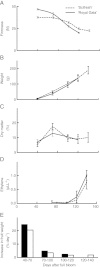
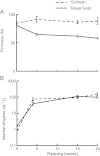


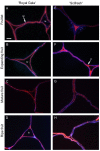
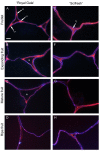

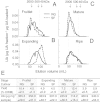
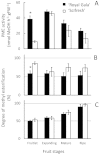

Similar articles
-
Lower cell wall pectin solubilisation and galactose loss during early fruit development in apple (Malus x domestica) cultivar 'Scifresh' are associated with slower softening rate.J Plant Physiol. 2015 Mar 15;176:129-37. doi: 10.1016/j.jplph.2014.12.012. Epub 2015 Jan 5. J Plant Physiol. 2015. PMID: 25602611
-
Solid-state 13C NMR study of the mobility of polysaccharides in the cell walls of two apple cultivars of different firmness.Carbohydr Res. 2014 Mar 11;386:1-6. doi: 10.1016/j.carres.2013.12.019. Epub 2014 Jan 3. Carbohydr Res. 2014. PMID: 24423413
-
Down-regulation of POLYGALACTURONASE1 alters firmness, tensile strength and water loss in apple (Malus x domestica) fruit.BMC Plant Biol. 2012 Aug 2;12:129. doi: 10.1186/1471-2229-12-129. BMC Plant Biol. 2012. PMID: 22856470 Free PMC article.
-
Cell wall metabolism in fruit softening and quality and its manipulation in transgenic plants.Plant Mol Biol. 2001 Sep;47(1-2):311-40. Plant Mol Biol. 2001. PMID: 11554479 Review.
-
Insights into cell wall changes during fruit softening from transgenic and naturally occurring mutants.Plant Physiol. 2023 Jul 3;192(3):1671-1683. doi: 10.1093/plphys/kiad128. Plant Physiol. 2023. PMID: 36823689 Free PMC article. Review.
Cited by
-
Cell wall dynamics during apple development and storage involves hemicellulose modifications and related expressed genes.BMC Plant Biol. 2016 Sep 15;16(1):201. doi: 10.1186/s12870-016-0887-0. BMC Plant Biol. 2016. PMID: 27630120 Free PMC article.
-
Changes in Metabolisms of Antioxidant and Cell Wall in Three Pummelo Cultivars during Postharvest Storage.Biomolecules. 2019 Jul 30;9(8):319. doi: 10.3390/biom9080319. Biomolecules. 2019. PMID: 31366134 Free PMC article.
-
Differential pulp cell wall structures lead to diverse fruit textures in apple (Malus domestica).Protoplasma. 2022 Sep;259(5):1205-1217. doi: 10.1007/s00709-021-01727-w. Epub 2022 Jan 5. Protoplasma. 2022. PMID: 34985723
-
Developmental changes in collenchyma cell-wall polysaccharides in celery (Apium graveolens L.) petioles.BMC Plant Biol. 2019 Feb 19;19(1):81. doi: 10.1186/s12870-019-1648-7. BMC Plant Biol. 2019. PMID: 30782133 Free PMC article.
-
Physiological Mechanisms of Citrus Fruit Cracking: Study on Cell Wall Components, Osmoregulatory Substances, and Antioxidant Enzyme Activities.Plants (Basel). 2024 Jan 16;13(2):257. doi: 10.3390/plants13020257. Plants (Basel). 2024. PMID: 38256810 Free PMC article.
References
-
- Oraguzie NC, Volz RK, Whitworth CJ, Bassett HCM, Hall AJ, Gardiner SE. Influence of Md-ACS1 allelotype and harvest season within an apple germplasm collection on fruit softening during cold air storage. Postharvest Biol Technol. 2007;44:212–219. doi: 10.1016/j.postharvbio.2006.12.013. - DOI
-
- Lakso AN, Corelli-Grappadelli L, Barnard J, Goffinet MC. An expolinear model of the growth pattern of the apple fruit. J Hortic Sci Biotech. 1995;70:389–394.
-
- Pratt C. Apple flower and fruit, morphology and anatomy. Hort Rev. 1988;10:273–308.
-
- Volz RK, Harker FR, Lang S. Firmness decline in ‘Gala’ apple during fruit development. J Am Soc Hortic Sci. 2003;128:797–802.
-
- Tong C, Krueger D, Vickers Z, Bedford D, Luby J, El-Shiekh A, Schackel K, Ahmadi H. Comparison of softening-related changes during storage of ‘Honeycrisp’ apples, its parents, and ‘Delicious’. J Am Soc Hortic Sci. 1999;124:407–415.
Publication types
MeSH terms
LinkOut - more resources
Full Text Sources
Other Literature Sources

